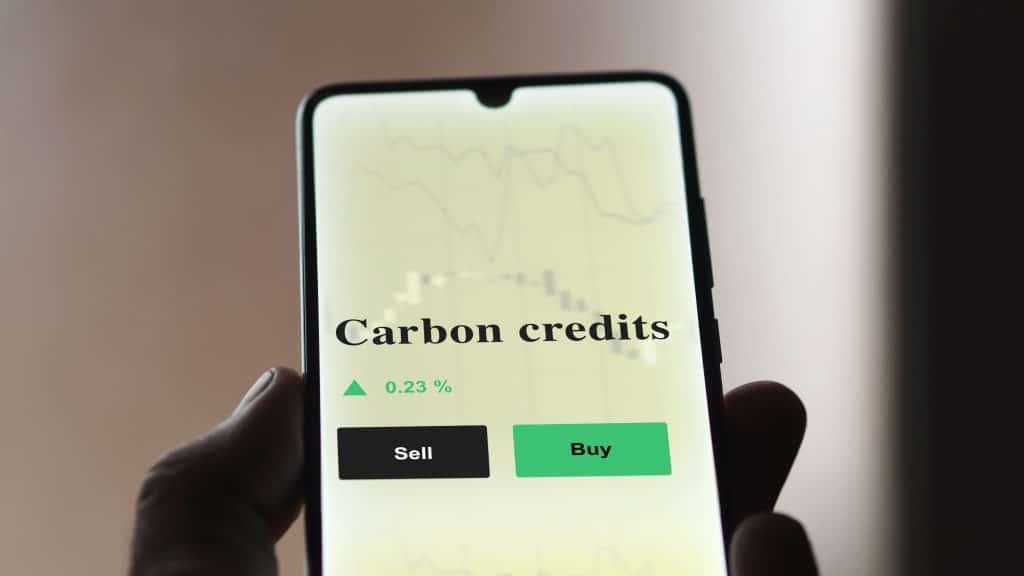Fight climate change and earn profits by investing in carbon credits, the innovative market-based solution that rewards businesses for reducing their carbon footprint

In this article, we will talk about how to invest in carbon credits. Diversification and asset allocation, in general, are key components of portfolio theory if you want to become an investor.
Carbon credit investing is becoming increasingly popular.
In fact, J.P. Morgan just invested $500 million in timberland (P.S. it wasn’t for the wood).
So, what actually are Carbon Credits?
Carbon credits are tradable permits that allow companies or individuals to offset their carbon emissions by investing in projects that reduce greenhouse gas (GHG) emissions.
Each carbon credit represents one tonne of CO2 or its equivalent GHG emissions that these projects have avoided or reduced.
Carbon credits aim to create a market-based mechanism that incentivizes GHG emissions reductions by allowing organizations or individuals to offset their greenhouse gas emissions while encouraging investment in carbon reduction projects.
From an investing standpoint, Carbon credits are an alternative investment like wine or real estate because of their illiquid nature and hard-to-value asset.
Many countries have adopted the use of carbon credits as a part of their climate policy framework.
What Is Carbon Credit Investing?
Carbon credit investing and trading involves buying and selling credits, stocks, mutual funds, or ETFs that represent a reduction in greenhouse gas emissions.
It can allow investors to support sustainability efforts and earn a profit. There are numerous advantages and risks of investing in carbon credits.
And while the carbon credit market is fairly nascent compared to traditional stock and bonds, it’s an industry that is worth taking a closer look at.
What Are The Advantages?
Investing in carbon credits can have several advantages, including:
Environmental Benefits
Carbon credits represent a reduction in greenhouse gas emissions, which can help mitigate the effects of climate change and global warming. By investing in carbon credits, you are contributing to a more sustainable future.
Potential for financial returns
Carbon credits can be bought and sold in various markets, and their value can fluctuate based on supply and demand. If you invest in carbon offsets or credits that increase in value, you can earn a financial return on your investment.
Portfolio Diversification
Carbon credits provide a unique opportunity to diversify your investment portfolio. Because they are not directly tied to traditional financial markets, they can provide a hedge against market volatility.

What Are The Risks?
While investing in carbon credits or companies that invest in the reduction of carbon credits can provide an opportunity for investors to support sustainability efforts and earn a profit, there are several risks associated with carbon credit investing, including:
Market Risk
The value of carbon credits can be volatile and influenced by various factors like regulatory, market demand, and economic conditions in carbon markets.
Regulatory Risk
The rules and regulations surrounding carbon credit markets can change quickly, making it difficult to predict the future value of credits.
Fraud Risk
The carbon credit market is vulnerable to fraud, including creating fake credits or selling credits that do not actually represent a reduction of Co2.
Reputational Risk
Investing in carbon credits can expose individual companies and investors to reputational risks if they become associated with companies or projects that fail to meet environmental or social standards.
Technology Risk
Carbon credit markets rely on accurate measurement and verification of emissions reductions, which can be challenging and subject to errors or manipulation.
Liquidity Risk
Carbon credit markets can be illiquid, meaning that it may be difficult to find buyers or sellers of credits when needed.
How To Start Investing in Carbon Credits
If you are interested in investing in carbon credits, there are numerous ways to get started.
Ways to invest in Carbon Credits include:
- Carbon Capture Stocks
- Carbon Credit Mutual Funds
- Carbon Credit ETFs
- Carbon Credit Futures
- Carbon Credit Investment Funds
Carbon Capture Stocks
Carbon capture, utilization, and storage (CCUS) is a technology that captures carbon dioxide (CO2) emissions from industrial processes, power plants, and other sources and stores it in underground geological formations, among other uses.
A few companies are involved in carbon capture technologies, including some publicly traded stocks.
Here are a few examples:
Carbon Clean Solutions (CCS). A UK-based company that offers carbon capture and utilization technologies to help reduce carbon emissions from industrial processes.
Carbon Engineering. A Canadian company that is developing Direct Air Capture (DAC) technology, which removes CO2 from the atmosphere and turns it into low-carbon fuels.
ExxonMobil. One of the world’s largest oil and gas companies, ExxonMobil, has invested in carbon capture technology and partnered with several companies to develop and commercialize CCUS solutions.
Schlumberger Limited. An oilfield services company that offers carbon capture and storage solutions to help reduce CO2 emissions from oil and gas operations.
Occidental Petroleum. A US-based oil and gas company that has invested in carbon capture technology and is working to develop CCUS projects.
Carbon Credit Mutual Funds
Carbon credit mutual funds are professionally managed investment vehicles that pool money from multiple investors to buy a portfolio of securities, including carbon credits.
The portfolio manager decides which carbon credit projects to invest in and manages the fund’s assets on behalf of the investors.
Carbon Credit ETFs
Another great way to invest in carbon credits is through Carbon credit ETFs (exchange-traded funds) are investment passively-managed products that expose investors to the carbon credit market. These funds invest in companies or projects that generate carbon credits through emission reduction initiatives, like renewable energy projects or energy efficiency programs.
ETFs are similar to mutual funds in that they invest in a basket of assets but are passively managed instead of actively managed like mutual funds.
Carbon Credit Futures
Carbon credit futures are a financial instrument that allows investors to speculate on the future price of carbon credits.
Futures contracts are agreements to buy or sell an underlying asset (in this case, carbon credits) at a specified price and date in the future.
Investing in carbon credit futures involves taking a position on the future price of carbon credits, with the goal of profiting from price fluctuations.
For example, an investor may buy a carbon credit futures contract if they believe that the price of carbon credits will increase in the future. If the price does, the investor can sell the futures contract higher than they paid, realizing a profit.
Investing in carbon credit futures requires specialized knowledge and experience in futures trading and is generally not for beginners.
Carbon Credit Investment Funds
Carbon credit investment funds are investment vehicles that enable investors to invest in a diversified portfolio of carbon credits generated by various emission reduction projects worldwide.
These funds can invest in various projects, like renewable energy, energy efficiency, and carbon capture and storage initiatives.
The primary objective of carbon credit investment funds is to generate a return on investment while supporting sustainable development and helping to reduce greenhouse gas emissions.
These funds typically invest in verified and certified carbon offset projects, which means that the carbon credits they generate are real and can be used to offset carbon emissions.
Carbon credit investment funds can take various forms, such as mutual funds, exchange-traded funds (ETFs), or private equity funds. The investment strategy and portfolio holdings can differ from fund to fund, depending on the fund’s objectives, investment style, and asset allocation strategy.
One advantage of investing in a carbon credit investment fund is that it exposes investors to the growing carbon market, without needing specialized knowledge or resources.
Carbon credit investment funds can also provide diversification benefits to a portfolio and help investors to align their investment goals with their environmental values.
The Bottom Line
Investing in carbon credits can be a way to support and promote carbon reduction efforts while potentially earning a financial return, but it is important to approach it like any other investment; with caution and thorough research.
Frequently Asked Questions
Do you need a lot of money to invest in carbon credits?
The amount of money required to invest in carbon credits can vary widely, depending on a range of factors, including market prices, minimum investment requirements, and the goals of the investor.
Currently, in global carbon markets, the price of carbon credits ranges from a few dollars to several hundred dollars per ton of carbon dioxide equivalent (CO2e).
Secondly, the minimum investment required to participate in carbon credit markets can vary depending on the platform or exchange used. Some platforms may require a minimum investment of several thousand dollars, while others may have no minimum investment requirement.
Finally, the level of investment will also depend on the goals of the investor. If an investor’s goalst the carbon emissions of a small business or personal activities, they may only need to purchase a relatively small number of carbon credits.
However, if an investor is looking to offset the carbon emissions of a large corporation or engage in more significant carbon trading activities, they may need to invest much more.

